Cooling Down After Watersports: Embrace Beach Life
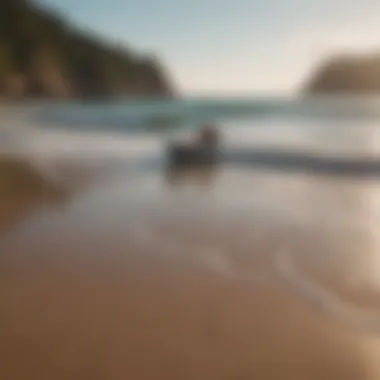
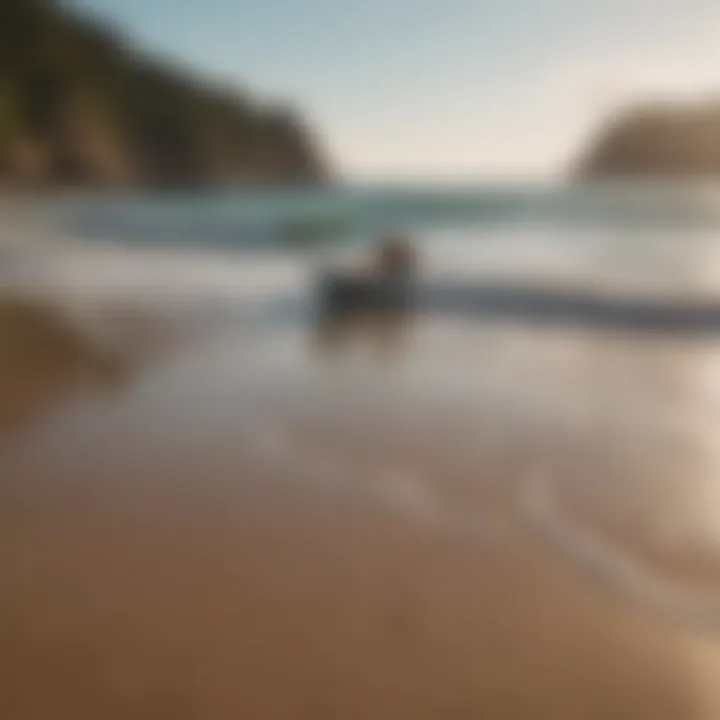
Intro
Living the beach bum lifestyle is more than just sun, surf, and sand. It's a celebration of freedom and a deep connection to the water, where windsurfing, paddleboarding, and kitesurfing become not just hobbies but essential parts of life. Yet, amidst the thrills of these watersports, it is crucial to recognize the value in cooling down, both physically and mentally. This article sheds light on how to unwinding gracefully after riding the waves, offering a detailed guide on hydration, mindfulness, and other techniques tailored specifically for watersports enthusiasts.
Gear Essentials
When it comes to preparing for a day of adventure on the water, the right gear is pivotal. Investing in quality equipment makes all the difference, not only for performance but for ensuring you stay comfortable and safe.
Top Picks for Watersports Equipment
- Surfboards: An all-rounder like the Soft Top Surfboard is perfect for beginners, providing a stable ride while learning to balance on the waves. For those more experienced, a performance board like the Shortboard offers agility and speed.
- Paddleboards: All-Around Inflatable Paddleboards are great for leisurely paddles yet sturdy enough for a bit of rougher water. Consider the Surf SUP, which is shorter and offers better maneuverability on waves.
- Kitesurfing Gear: A dependable kite like the Epic Kite varies in size for different wind conditions, essential for both novice and seasoned pros. Pair it with a twintip board for versatility on the water.
Maintenance and Care Tips for Gear
Maintaining your gear prolongs its life and ensures it works optimally when you need it. Here are some solid tips for specific equipment:
- Surfboards: Rinse off with fresh water after use to remove salt and sand. Store your board away from direct sunlight or extreme heat to avoid delaminating.
- Paddleboards: Make sure to dry the board after each use to prevent mold or mildew. Regularly inspect for any damages, and if present, get them repaired immediately.
- Kitesurfing Equipment: Keep the lines clean and untangled to ensure smooth rides. After a session in saltwater, rinse and dry your kite before packaging it up.
"Proper care of your equipment is just like tending to a good garden—a little love goes a long way."
Techniques and Tips
Enhanced performance in watersports comes not just from rigorous practice but also from knowing some essential techniques that enhance your experience.
Beginner Tips for Each Watersport
Starting can be daunting, but these tips can ease the process:
- Surfing: Focus on paddling for balance. Practice popping up on dry land before hitting the waves.
- Paddleboarding: Keep your feet shoulder-width apart, bending your knees slightly for better stability.
- Kitesurfing: Before flying the kite, understand the wind direction. Practice controlling the kite on land before heading out.
Advanced Techniques for Skill Enhancement
As skills develop, refinement becomes key. Consider implementing these strategies:
- Surfing: Work on your turns by digging the rail into the water and shifting your weight to your back foot.
- Paddleboarding: Mastering quick pivot turns can greatly enhance navigation through waves.
- Kitesurfing: Focus on edging techniques; it helps with speed control and maintaining a consistent pull.
This exploration around the beach bum lifestyle highlights not only the technical aspects of enjoying watersports but the importance of relaxation that follows the thrill. In diving into these topics, enthusiasts can find a balanced approach to both adventure and tranquility, creating an enriched experience on the water.
Understanding the Beach Bum Philosophy
The beach bum lifestyle is more than just a sun-soaked day by the water. It embodies a sense of freedom, leisure, and connection to nature—important elements that are vital for both our mental and physical well-being. For surfers, paddleboarders, and kitesurfers alike, this philosophy stands as a guiding principle in their everyday lives. Understanding the beach bum philosophy lays a foundation for recognizing the significance of relaxation and how it influences performance in watersports.
Defining the Term
At its core, "beach bum" refers to a person who prioritizes a laid-back, coastal way of life. This term might conjure up images of lounging on a sandy shore without a care in the world. However, it goes deeper than that. Being a beach bum can symbolize someone who seeks balance—between adventure and repose. They are often individuals who care for their well-being, finding joy not just in the thrill of watersports but also in serene moments spent on the beach or nearby.
The beauty of this lifestyle lies in its flexibility. There’s no strict definition, which allows everyone to mold it to their liking. Whether you live permanently at the beach or visit every chance you get, adopting this philosophy can positively affect your approach to life. It’s about letting the wind, waves, and warm sun bring you peace.
Embracing a Relaxed Lifestyle
Embracing a relaxed lifestyle is essential for those wanting to enjoy watersports fully. The benefits of this calm approach are numerous and noteworthy. By simply slowing down, we give ourselves the opportunity to absorb the beautiful surroundings, appreciate the ocean’s whispers, and engage with fellow beachgoers.
Consider the physiology involved; a relaxed mental state can lead to lowered blood pressure and decreased stress levels. This is crucial for anyone spending long hours in activities like surfing or kitesurfing, where focus and agility are paramount.
In addition, this lifestyle encourages:
- Mindfulness Practices: These involve techniques that enhance your awareness of the present moment. They can be as simple as observing the tides or feeling the sand beneath your toes.
- Social Connections: Engaging with others who share a passion for the beach creates a supportive community. With shared experiences, the bonds become stronger, adding depth to one’s beach bum lifestyle.
- Physical Recovery: After a day in the waves, the right relaxation techniques can help in muscle recovery and prepare the body for the next adventure, ensuring lasting enjoyment of watersports.
In summary, the beach bum philosophy is not just about being at the beach. It encourages a holistic view of life that promotes balance, mindfulness, and community, making it a potent tool for anyone willing to adopt its principles.
The Importance of Cooling Down
As anyone who's spent a day riding the waves or gliding across tranquil waters knows, cooling down after an intense session isn't just about comfort—it's essential for both body and mind. Taking the time to properly cool down can significantly enhance your overall enjoyment of watersports while promoting a healthier lifestyle. Engaging in these relaxing practices is like finding an oasis after a sun-soaked adventure, providing physical and psychological benefits that can transform a simple day at the beach into a fulfilling experience.
Physiological Benefits
Cooling down after activities, especially in an environment as hot as the beach, plays a pivotal role in physiological recovery. By allowing the body to transition gradually from activity to rest, you help regulate heart rate and lower core body temperature. Here are some specific benefits:
- Muscle Recovery: When you stop engaging in high-intensity activity, muscles are often strained and fatigued. Cooling down encourages blood flow back to the heart, aiding in the removal of lactic acid buildup, which can reduce soreness later.
- Flexibility Improvement: Soft, slow movements during the cooldown phase can promote flexibility. It's like giving your muscles a gentle reminder to stretch and unwind, which can help avoid stiff joints or pulled muscles.
- Hydration Status Maintenance: Cooling down often includes rehydrating. Replenishing lost fluids promptly—especially in the heat—ensures that your body remains in optimal condition for your next escapade.
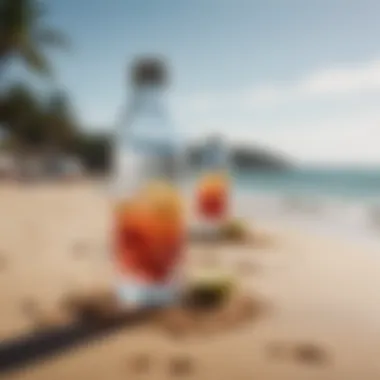
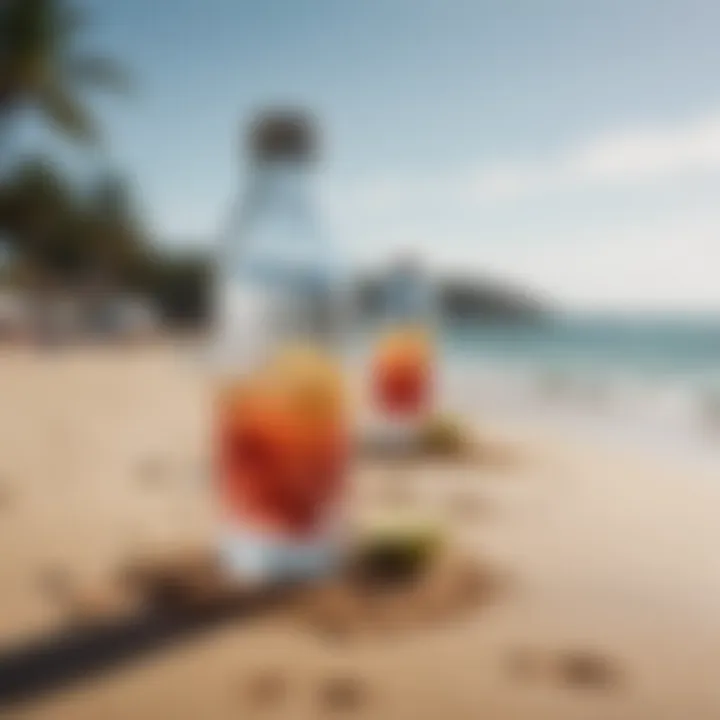
Getting into cooler water after your activities can have a profound effect as well. The sensation of a refreshing dip can soothe sore muscles—think of it as nature's spa treatment, easing your way into relaxation. Many surfers find that lingering in the surf, feeling the gentle waves lap against their bodies, enhances this cooling experience immensely.
Psychological Advantages
The psychological effects of cooling down are just as significant. The act of slowing down can shift your mindset from the intensity of the sport to a leisurely beach vibe, which is crucial for mental recovery. When one takes a moment to chill after exhilarating watersports, it can lead to numerous benefits:
- Stress Reduction: Not only does cooling down physiological tensions, but it also helps relieve mental stresses accumulated during high-energy activities. The transition allows the mind to decompress, offering a moment of clarity amid the hustle of life at the beach.
- Enhanced Focus on Well-Being: Engaging in cooldown practices such as meditation or breath techniques focuses your thoughts on well-being, fostering a deeper connection with yourself and the environment. You begin to appreciate the sun's warmth or the sound of the waves, creating a tranquil atmosphere.
- Strengthened Social Bonds: Cooling down often involves relaxation alongside friends or fellow beach attendees. Sharing this time can deepen social connections. It creates an informal setting where stories can be exchanged over snacks or shared experiences, reinforcing community ties.
"Taking a moment to just breathe and soak in your surroundings might be the best part of the day. It’s not always just about the waves but the people and the calm moments in between."
Indeed, establishing a routine for cooling down after watersports is vital. Embracing these practices can make for not only a smoother transition back to normalcy but also an enriched beach life, balancing thrill with relaxation.
Hydration Strategies for Beach Bums
Being a beach bum isn’t just about lounging under the sun or riding the waves; it’s deeply intertwined with how you manage hydration. In an environment where sun rays kiss your skin, and salty winds caress your face, staying hydrated becomes essential. For surfers, paddleboarders, and kitesurfers, hydration strategies are more than a choice; they are critical for performance and recovery.
Water is not simply a thirst quencher; it plays a pivotal role in regulating body temperature, maintaining energy levels, and even enhancing focus while engaging in watersports. The heat and exertion can drain your body of essential fluids at an astonishing pace. Ignoring your hydration needs could lead not only to a less enjoyable beach experience but also to long-lasting effects on your health.
Types of Hydration
Typically, hydration can be approached through various avenues, each offering unique benefits:
- Water: Let's start with the most straightforward choice—plain ol' water. It’s the cornerstone of hydration, vital for maintaining cellular functions. On especially hot days, aim for at least 2 to 3 liters of water, depending on your activity level.
- Electrolyte Drinks: If you're sweating buckets while enjoying your sport, electrolyte-rich drinks can aid in replenishing lost sodium, potassium, and magnesium. Be wary, though, as some of these drinks can be loaded with sugar, which might defeat the purpose. Look at options that provide a balance of electrolytes without excessive sugar content.
- Coconut Water: This nature’s juice is a fantastic alternative. It’s hydrating, tastes refreshing, and is packed with essential electrolytes that can keep you replenished after intense activities.
- Herbal Teas: Surprisingly, some herbal teas, especially when served cold, can be a refreshing way to hydrate. Herbal blends such as chamomile or peppermint provide a unique twist and might even soothe your senses as you sip on them by the shore.
Each of these hydration types plays a part, but knowing what your body requires at a given moment is what makes the difference.
Infusing Water with Flavor
Sometimes, plain water can feel a tad tiresome, especially after a long day of sun and surf. Infusing water with flavors opens a whole new world of hydration possibilities.
- Fruits and Herbs: Tossing in slices of lemons, limes, or even sprigs of mint can elevate your water game. Citrus adds refreshing zest, while herbs introduce aromatic qualities that make sipping enjoyable.
- Berries: Strawberries, blueberries, and raspberries not only add a lovely hue but are also loaded with antioxidants, making your drink a functional choice for fighting off the oxidative stress of sun exposure.
- Cucumbers: Consider it a spa treatment for your taste buds. Cucumber-infused water feels incredibly refreshing and can be particularly desirable on a hot day.
- Chia Seeds: Yes, these tiny wonders can be added to your hydration, absorbing water and providing a texture change. They also offer additional nutrients like omega-3 fatty acids.
Infusing water isn’t just about taste; it enhances the overall experience of your time at the beach, making something as simple as hydration feel special. Incorporating these strategies into your routine can create a more enjoyable beach lifestyle, ensuring that you’re not just another sun-soaked beach bum, but a well-prepared water enthusiast ready to embrace both adventure and relaxation.
Cooling Techniques After Watersports
Cooling down after a day on the water isn’t just a luxury; it’s a crucial step in ensuring both your body and mind recover properly. For those who dedicate their lives to beach activities, such as surfing, paddleboarding, or kitesurfing, understanding how to effectively cool down can enhance performance and well-being. The sun-soaked adventures we eagerly dive into leave us exhilarated but also, at times, depleted. Cooling techniques can help ease muscle tension, regulate body temperature, and even improve overall mood, allowing you to transition smoothly from high-energy activity to a state of relaxation.
The Art of Slow Movements
In the midst of thrilling waves and playful winds, it’s easy to overlook the importance of slow movements once we step back from the water. Engaging in slow, deliberate motions can pave the way for recovery. Think of it as a way to integrate every muscle you've just poured your energy into.
When you move slowly, you invite your body to sit in the warmth of the experiences just had. A gentle stroll along the shoreline, for example, allows cooler ocean air to touch the skin, easing that post-activity heat. Moreover, this leisurely pace invites mindfulness, where you can savor the beauty of your surroundings. Slow movements help to promote circulation, alleviate tightness in the muscles, and facilitate a calmness that resonates through the body.
Breath Techniques to Calm
Breathing techniques are an underappreciated yet powerful tool in the beach bum toolkit. After an exhilarating session, you might find your heart racing and thoughts swirling. Focusing on breath can ground you, providing instant relief.
Here’s a simple practice:
- Inhale deeply through your nose, allowing your abdomen to expand fully.
- Hold this breath for a count of four.
- Slowly exhale through your mouth, letting go of any tension.
- Repeat this cycle five to ten times.
As you breathe, visualize the waves rolling onto the shore—like nature’s own rhythm aligning with your soul's pace. This connection not only calms your nervous system but also enhances oxygen flow, rejuvenating tired muscles post-adventure.
Gentle Stretching
Stretching isn’t merely about improving flexibility; it also serves as a fundamental component of cooling down. Gentle stretching helps ease tension built up from rigorous watersports and releases any lingering tightness that could lead to injury down the line.
Consider incorporating stretches such as:
- Neck Rolls: Slowly roll your head from side to side to release tension in your neck.
- Shoulder Shrugs: Lift your shoulders up towards your ears and then release them. Repeat a few times to relax the muscles.
- Side Bends: Stand tall and gently lean to one side and then the other, stretching out your sides.
- Hamstring Stretch: Sit on the sand, extend a leg, and reach towards your toes for a soothing stretch.
By taking just a few moments to stretch, you help your body transition from action to stillness, leaving you ready to soak in the serene beach life. Every stretch is like a wave, moving through and washing away fatigue.
"In strategies, you create space; in slowing down, you let the world around you come into focus."
Cooling techniques are essential for rekindling balance after the exhilarating pursuit of watersports. Each method discussed here encourages a flow between activity and relaxation, contributing to an enriched beach bum lifestyle.
Mindfulness and Relaxation Practices
Mindfulness and relaxation practices are crucial for beach bums, especially after a day spent engaging in exhilarating watersports. These techniques not only help in cooling down physically but also contribute to mental clarity and emotional well-being. Amidst the surroundings filled with the gentle sound of waves and the feel of warm sand, focusing on mindfulness opens the door to a deeper connection with the environment and oneself.


In the context of an active beach lifestyle, mindfulness promotes awareness of the present moment, allowing individuals to savor their experiences without getting bogged down by past worries or future anxieties. These practices can significantly enhance one’s enjoyment of leisure time, turning simple moments into cherished memories.
Meditation Techniques
Meditation isn't just for those who sit cross-legged in silence; it can be a lifeline for beach bums looking to settle their minds after an adrenaline-fueled day. Various meditation techniques cater to different preferences and skill levels.
- Breath Awareness: Simply bring attention to your breath. Inhale deeply through your nose, hold for a moment, then exhale slowly. This is a way to ground yourself, making it perfect to do right after a surf session.
- Guided Visualization: Picture yourself on the perfect wave, or lying on your beach towel under a palm tree. This method transports you elsewhere, helping to relax and relieve tension.
- Body Scan: As you lay on the sand, focus on different parts of your body, from your toes to your head, noticing any tension and consciously letting go of it.
- Walking Meditation: Practice mindfulness while leisurely walking along the shore. Feel the sand beneath your feet and the rhythm of the ocean waves.
Whichever technique you choose, the key is consistency. Just a few minutes a day can yield long-lasting gains in your overall state of mind.
Nature Sounds as Therapy
Nature has a remarkable way of healing, a fact backed by various studies. Tuning into the sounds of the beach—waves crashing, seagulls calling, and the rustle of palm trees—serves as a natural form of therapy. Listening to the symphony of nature induces a sense of peace.
Harnessing these soothing sounds can lead to several benefits:
- Stress Reduction: Consistent exposure lowers cortisol levels, promoting a calmer state of being.
- Enhanced Focus: Nature sounds help to drown out distractions, making it easier to think clearly.
- Improved Sleep Quality: Evening beach sounds aid sleep for those who feel restless or anxious.
To integrate nature sounds into your routine, consider bringing a portable speaker with curated playlists or using apps that replicate ocean sounds. Effective as they are refreshing, they’ll bring the coastline into your personal space, reminding you of the tranquility of the beach.
"In every outthrust headland, in every curving bay, in every grain of sand there is the story of the earth." - Rachel Carson.
Ultimately, these mindfulness and relaxation practices are not just lifestyle adjustments; they're a pathway to richer experiences. By choosing to embrace these concepts, beach bums can ensure that their love for watersports balances seamlessly with inner peace.
Optimal Use of Beach Resources
The sun-soaked shores, where waves meet sand, offer a treasury of resources that can enrich the beach bum lifestyle. Understanding how to effectively utilize these elements not only enhances your enjoyment but also plays a crucial role in cooling down and recovering after engaging in watersports. Both shade and breeze are on the top of this list, providing natural remedies and restorative qualities that contribute to overall well-being.
Utilizing Shade Effectively
Shade is a vital refuge from the fierce midday sun. Picture this: after an exhilarating session of paddleboarding, you come ashore, body buzzing with the thrill of the water but facing the uncomfortable heat radiating from the sand. Seeking shade should be instinctual, like a turtle finding its burrow. Utilizing trees, umbrellas, or canopies allows your body to recover while also preventing overheating.
- Benefits of Shade
- Temperature Regulation: Shade provides a critical reduction in heat exposure, helping maintain core body temperature.
- Skin Protection: Protecting yourself from UV rays reduces the risk of sunburns, which can ruin a beach day.
- Relaxation Space: Finding a comfortable shaded area encourages a more profound state of relaxation, which is essential for winding down after physical activity.
When seeking shade, consider both natural and artificial options. Some prefer the allure of palm trees, while others might opt for a beach umbrella. Regardless of the choice, dedicating a spot for shade at your beach setup can make a world of difference. Make sure to pack an inflatable lounge chair or a towel to sit on, and you’re set.
Invigorating Ocean Breezes
The ocean breeze is more than just a pleasant caress against your sun-kissed skin; it serves as a natural cooling agent. There’s something about that fresh salty air that revives and rejuvenates any weary beach bum. After your kitesurfing escapades, the gentle sea wind can feel like heaven.
- Why Ocean Breezes Matter
- Natural Cooling: The breeze can lower body temperature, making it easier to cool down after an active day.
- Enhanced Mood: There’s science behind that feel-good factor from fresh air. Being near the ocean is known to elevate mood and reduce stress.
- Air Quality: Ocean breezes carry a mix of negative ions which can improve air quality, providing a natural detox.
Make the most of these oceanic vents by positioning yourself near windbreaks or not too far from the waterline, where breezes are often stronger. You might find it worthwhile to engage in activities that encourage awareness of this element, like stretching or meditative breathing, as winds weave their way around you.
"The beach is not just a place; it’s an experience. Utilize every resource around you for a complete encounter with nature."
Incorporating these beach resources into your cooling-down routine not only enhances your relaxation practices but also fosters a deeper connection with the natural environment. Understanding when and how to harness shade and ocean breezes can transform your moment of rest into an enriching experience, keeping you revitalized and ready for the next watersport adventure.
Social Connections at the Beach
Social connections at the beach are more than just fleeting encounters; they serve as the cornerstone of the relaxed lifestyle embraced by surf, paddleboard, and kitesurf enthusiasts. These connections provide not only camaraderie but also a sense of belonging that enriches the beach bum experience. Sharing enduring moments, exchanging tips on the latest gear, or finding an instant friend through a mutual passion can enhance the escapade at hand and create lasting ties that go beyond the sandy shores.
Creating Community Bonds
Creating community bonds is a vital part of the beach lifestyle. When individuals come together with a shared interest in watersports, it fosters a sense of relationship that can lead to deeper connections. Collaborating for beach cleanups, organizing paddleboarding meet-ups, or simply gathering for a sunset surf session all cultivate an environment of trust and mutual support.
It's essential to recognize that these friendships can also help in personal development. For instance, local surfing clubs or communities often host events that encourage skill-sharing and mentorship among beginners and seasoned pros alike. These gatherings can lead to life-changing experiences, allowing individuals to grow both in ability and confidence.
"The beach isn’t just a place, it’s a community where everyone—no matter skill level—can come together and make life-long friends."
Sharing Experiences and Stories
Sharing experiences and stories serves as the lifeblood of any beach social scene. It's not just about what surfboard did you ride or how high did you jump; it’s about the tales behind those moments. A casual chat over coconut water or a bonfire can spark laughter, advice, and insights that enhance the whole lifestyle.
These stories often range from encounters with local marine life to epic waves that felt impossible to conquer. They can serve as inspiration, motivate others to take risks in their own pursuits, and solidify connections in the process. The act of sharing translates into community wisdom, where newcomers learn the ropes from seasoned beach bums.
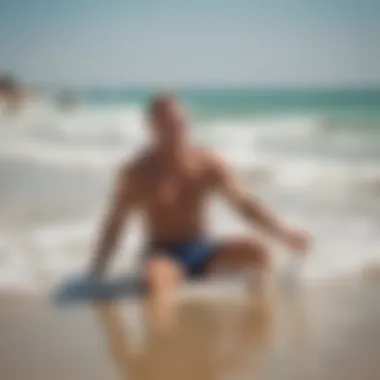
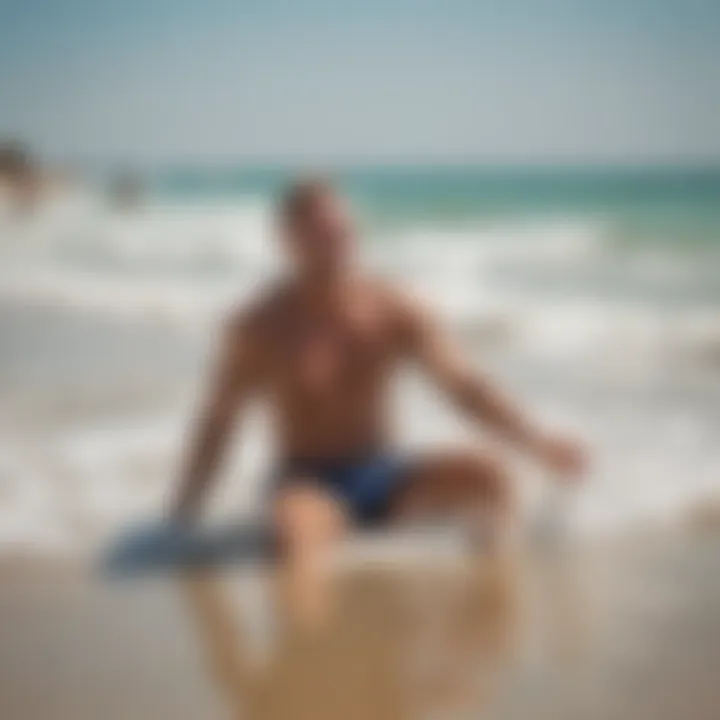
The rich tapestry of shared experiences allows each person to feel heard and valued. Whether you are reminiscing about that thrilling downwinder or swapping tips on the best times for ocean swells, these conversations become stepping stones to forge deeper bonds with fellow enthusiasts.
In essence, the relationships born on the beaches around these shared interests do far more than occupy time; they create a network that champions not just the enjoyment of water sports but the nuances of life itself— admiration, respect, and joy characterized by a sense of place and purpose.
Balancing Activity and Leisure
Finding harmony between the thrill of activity and the serenity of downtime is essential for beach enthusiasts. The beach bum lifestyle celebrates both excitement and relaxation, allowing watersport lovers to fully enjoy their time by the shore. When the sun hits high noon and the waves are calling, it can be tempting to dive into every adventure without a second thought. However, understand that this lifestyle isn't a marathon; it's more like a leisurely stroll through seaside vistas.
Scheduled Adventures vs. Downtime
When planning your days at the beach, balance is key. Consider establishing a schedule that dedicates time for both exhilarating watersports—like surfing perfect waves or paddleboarding across calm currents—and moments for relaxation under the swaying palms. Knowing when to push your limits and when to unwind is critical for both physical and mental well-being.
Don’t underestimate the power of a few lazy hours on the sand, allowing your body to recharge. Think about your activities like this:
- Adventure Days: Set aside specific days for activities like kitesurfing or windsurfing. On these days, wake early, energize with a healthy breakfast, and hit the waves. Feel the thrill, but be cautious not to overdo it. Fatigue can sneak up like a thief at night, often just when you least expect it.
- Rest Days: Designate days or afternoons for lounging. Feel the sand between your toes and let the ocean breeze wash over you. These moments spent indulging in a good book or simply soaking in the environment can vastly improve your recovery.
Listening to Your Body's Cues
One of the most insightful aspects of balancing activity and relaxation is cultivating an awareness of your body’s signals. As you spend time in the sun and sea, it's vital to pay heed to your body's responses. For instance, if you start feeling a bit run down or notice aches and pains that weren't there before, it might be your body’s way of saying, "Hey, slow down a moment!" Ignoring such signs can lead to burnout or worse, injuries.
To get in tune with your body:
- Self-Check: After a vigorous session of riding the swell, take a moment to assess how you feel. Are your muscles sore? Is your energy waning? Recognizing when to stop can be more beneficial than pushing through the pain.
- Implement Recovery Practices: Coupling activities with recovery methods such as gentle stretching or even a dip in cool water can significantly aid your body's ability to recover. A neglected body might find itself screaming for attention down the road.
- Flexibility with Scheduling: While sticking to a plan can be beneficial, remain flexible. If the ocean is calling but your body isn’t feeling up to it, consider swapping an adventure for some relaxation. Flexibility transforms frustration into appreciation.
“Balance is not better time management, but better boundary management.”
- Betsy Jacobson
In essence, balancing activity and leisure isn't just about fitting everything into a day; it's about crafting a lifestyle that acknowledges the joys of both. By scheduling adventures wisely and tuning into your body's messages, you create a more sustainable beach bum lifestyle, enriching your experiences both in and out of the water.
The Role of Nutrition in Recovery
When it comes to enjoying a day on the beach, especially after engaging in active watersports, nutrition plays a pivotal role in helping the body recover. The choices you make about what to eat not only replenish energy reserves but also aid in muscle repair and hydration, creating a balanced foundation for both further activities and leisure. Ignoring your body's nutritional needs post-activity can lead to fatigue and potentially diminish the enjoyment of that laid-back beach lifestyle you cherish.
Post-Activity Snack Options
After paddling out on your board or riding the waves, the urge to refuel can be strong. Think about snacks that will hit the spot and provide lasting energy. Here are a few solid options:
- Greek yogurt with fruit: This combination offers a healthy dose of protein and antioxidants, perfect for muscle recovery.
- Hummus with veggies or whole-grain pita: Packed with fiber and plant-based protein, hummus helps satisfy cravings while providing essential nutrients.
- Trail mix with nuts and dried fruit: A classic for a reason, this snack is portable and rich in healthy fats and sugars.
- Energy bars: Look for ones made with whole ingredients. They’re convenient when you want something quick and easy after a long surf session.
Don’t forget the importance of hydration as well! Pair your snack with water or a natural electrolyte drink to hydrate effectively.
Importance of Balanced Meals
Balanced meals are essential when you’re engaged in a routine filled with physical exertion. Having a well-rounded plate can maximize your time on the beach, with fewer injuries and quicker recovery. Each component plays a role:
- Carbohydrates: They’re your body’s primary source of energy. Think brown rice, quinoa, or sweet potatoes.
- Proteins: Vital for repairing muscles that work overtime while you’re catching waves. Chicken, fish, tofu, or legumes are great choices.
- Fats: They help with the absorption of fat-soluble vitamins. Incorporate nuts, seeds, or avocados into your meals.
- Vegetables: They’re loaded with antioxidants and vitamins. Leafy greens and colorful veggies ensure you get a wide range of nutrients.
Keeping these elements in mind is key to sustaining energy levels and promoting the recovery process.
"Nutrition is not just what you eat; it's about how well you replenish and recover to keep enjoying the surf."
With these food tactics, you’ll find yourself caring less about fatigue and more about enjoying the next wave. Make your meals as much a part of the beach bum philosophy as the surf and sun.
Seasonal Considerations
Understanding the dynamics of seasonal changes is paramount for beach enthusiasts and watersport lovers. The variance in weather can drastically influence not only the enjoyment of your beach days but also impact how to properly cool down and recover post-activity. The need to adapt your approach depending on the season can enhance your overall experience and well-being.
Summer Heat Management
During the scorching summer months, the sun can be relentless. Staying cool becomes not just a comfort but a necessity. Here are several strategies to help you keep your cool during summer:
- Hydration is Key: Drinking plenty of fluids is vital. Water replenishes what you lose while sweating and contributes to your body’s cooling mechanism. Flavored waters with fruits such as watermelon or lemon can make hydration more enjoyable.
- Timing Your Activities: Try to engage in watersports early in the morning or late in the evening when temperatures are milder. Midday sun can zap your energy faster than you expect, making cool downs difficult.
- Use Cooling Towels: These handy tools can be soaked in water and draped around your neck or head, helping to lower your body temperature effectively.
It's essential to listen to your body. Overexertion can lead to heat exhaustion, which you really want to avoid when basking under the sun.
"In the summer, one must know when to ride the wave and when to simply lounge under the umbrella."
Thus, knowing your limits is a major part of being a responsible beach bum. By being smart about your health, you can maintain your energy levels for all-day fun.
Winter Beach Adventures
Think beach fun has to halt with the drop in temperature? Not a chance. Winter beach outings can be enchanting, with fewer crowds and the crisp air offering a different kind of thrill. Embrace the chill with these tips:
- Layer Up: Dressing for success isn’t just a saying. Wearing layers allows you to manage your body temperature effectively. Start with a moisture-wicking base layer and build up for warmth.
- Waterproof Gear: Opt for wetsuits designed for colder temperatures when engaging in watersports. This will keep your body warm while allowing freedom of movement.
- Enjoy Warm Beverages: After a paddle in the cool surf, nothing beats sipping on a hot cocoa or herbal tea. This is not only comforting but also helps you to warm up.
The winter beach also offers its own unique beauty. The sound of waves crashing against a chilly shore can be both soothing and invigorating. With fewer beach-goers, you might even find a sense of solitude that enhances the experience.



